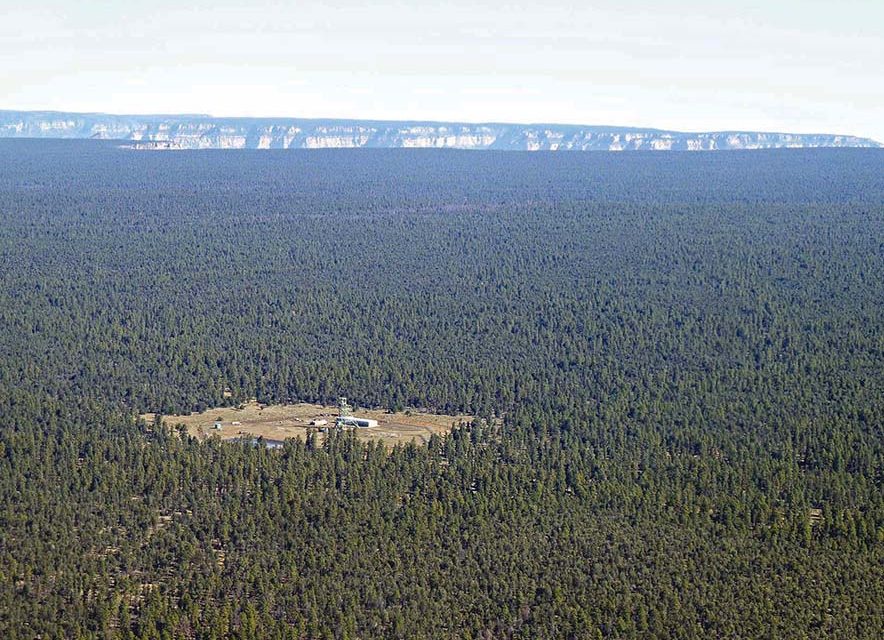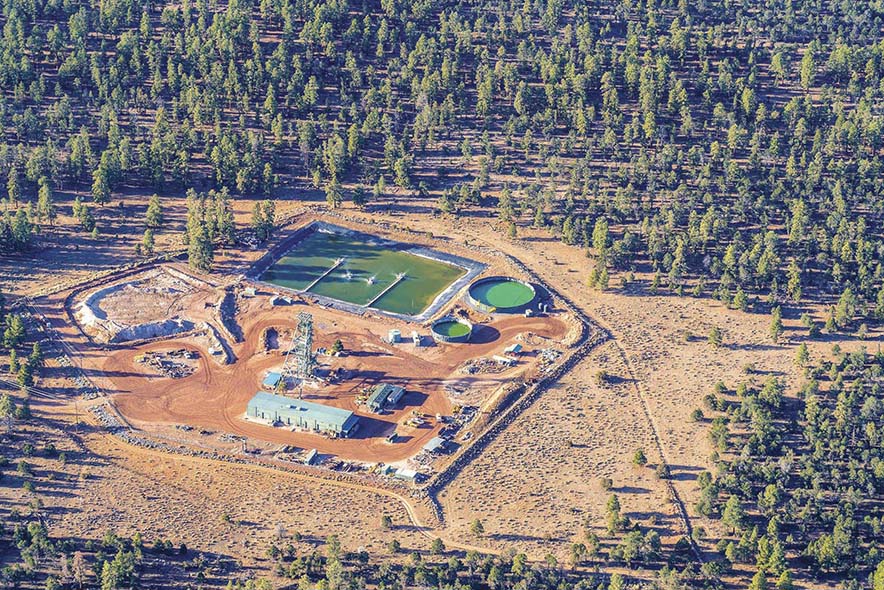
Water data from Pinyon Plain Mine shows spike in heavy metals

Courtesy | Bruce Gordon, Ecoflight
The Pinyon Plain Mine, formerly the Canyon Mine, sits on the Kaibab National Forest, south of the Grand Canyon, near the Havasupai Tribe’s sacred mountain, Red Butte.
WINDOW ROCK – The Pinyon Plain Mine poses a risk to the groundwater systems, according to the Grand Canyon Trust.
With over 9 million gallons of water pumped out of the Pinyon Plain mineshaft in December 2023, flooding has caused spikes in heavy metals in the water, according to Energy Fuels Resources’ Pinyon Plain Mine 2023 aquifer protection permit report.

Courtesy | Bruce Gordon, Ecoflight
A closeup of the Pinyon Plain Mine, formerly the Canyon Mine, footprint.
The report suggests water pumped out of the mine and water quality testing results for the state regulators at the Arizona Department of Environmental Quality.
Results indicated uranium was six times the U.S. Environmental Protection Agency’s max contaminant level for safe drinking water. Lead was 243 times and arsenic was 812 times – a huge jump since the last quarter of 2022, when uranium was four times, lead was three times, and arsenic was 17 times the safe drinking water level, said Amber Reimondo, the energy director for Grand Canyon Trust.
Reimondo said there was a 150 percent increase in uranium, a 4,700 percent increase in arsenic, and an 8,100 percent increase in lead.
With more than 66 million gallons of water being pumped, the Grand Canyon Trust stated that there is enough water to meet the needs of every person in the nearby town of Tusayan, Arizona.
No uranium is safe
The Pinyon Plain Mine exists because of the 1872 General Mining Law, said Carletta Tilousi, a Havasupai Tribe member, during a panel discussion on June 26 regarding uranium and the Grand Canyon hosted by KJZZ News.
Tilousi is a former Havasupai tribal council member and a member of the White House Environmental Justice Advisory Council. She says the mining law is an old law that allows international mining companies to stake uranium claims on public lands.
The Havasupai Tribe opposed the mine before it opened in 1968. It sits on the Kaibab National Forest, near the Havasupai Reservation.
“It sits above our main water source, the Redwall-Muav Aquifer,” Tilousi said. Growing up in the Supai Village, she was told by elders that there was a lake of water underneath, and it needed to be protected.
“If we do not stop these mining activities occurring on top of our water source, it will not only contaminate the Havasupai Creek, it’s going to contaminate all downstream that are relying on the Colorado River,” said Tilousi, who added that the Havasupai Tribe are located below the Grand Canyon, where uranium activity is taking place at their sacred mountain Red Butte.
The mine sits roughly nine miles from the Grand Canyon National Monument Park in Tusayan, Arizona. Energy Fuels Resources began extracting uranium for the first time in December 2023.
Questions were asked of Energy Fuels Resources which Tilousi stated Energy Fuels allegedly has not responded to the Havasupai Tribe’s questions.
“We really need to know that this type of mining that is happening right now, is that safe?” Tilousi asked. As far as the mining company reaching out to tribes, she believes citizens of Arizona deserve an explanation of what’s happening to their main water source.
“They should be here,” Tilousi stated about Energy Fuels Resources being part of the panel discussion, which included Leslie Begay, a former uranium miner and a Vietnam Marine veteran; Leona Morgan, the co-founder of HaulNo!, a nonprofit working to stop what it calls “nuclear colonialism in the Southwest”; and Monica Yellowhair, the outreach program director at the University of Arizona Cancer Center.
Claims were made that the mine threatens to contaminate underground water sources with radioactive materials and arsenic, said Laura Crossey, a distinguished professor of earth and planetary sciences at the University of New Mexico in Albuquerque.
She referred to the United States Geological Survey, known as USGS, which stated on its website how art illuminates the Grand Canyon by exploring the environmental puzzle, which explains uranium mining’s impact through illustrations and science.
However, Crossey said, “We should not be exploring an environmental puzzle” but “should be preventing an irretrievable hard to the regional aquifer system.”
With over 20 years of studying groundwater activity, Crossey’s research, which was published in the “Annual Review of Earth and Planetary Sciences: Hydrotectonics of Grand Canyon Groundwater,” in February 2024, which was supported by Grand Canyon National Park Research Permits, allowed her to study the groundwater sources.
In her extensive research, she believes what the USGS report on “Balancing Natural Resource Use and Extraction of Uranium and Other Elements in the Grand Canyon Region,” which elaborates on why the Grand Canyon extracts uranium.
Crossey said what USGS reported seemed to trivialize the real consequences and promulgate inaccuracies about the actual mine setting and hydrology.
The Pinyon Plain Mine is above the deep Redwall-Muav Aquifer, which seeps and springs in the Grand Canyon and is the Havasupai Tribe’s sole source of drinking water.
In 2016, miners at the mine pierced groundwater, and water began rushing into the mine shaft. Since then, more than 66 million gallons of water containing high levels of metals including uranium, arsenic, and lead have been pumped out of the mine into an evaporation pond.
This resulted in water being misted into the air to speed up evaporation, or even trucked illegally over state lines to the White Mesa Mill for disposal in Blanding, Utah, said Amber Reimondo.
“Assurances made by the mining companies and regulators are far from guarantees and, in our opinion, ignore more recent and important scientific indications that the risk to groundwater is real and will linger long after the mining company has left,” she added.
Concerns regarding these acts have been ongoing for many years.
Faults and fractures
According to Grand Canyon Trust, the Havasupai Tribe alongside the Hopi Tribe, Hualapai Tribe, Kaibab Band of Paiute Indians, Las Vegas Tribe of Paiutes, Moapa Band of Paiute Indians, Paiute Indian Tribe of Utah, Shivwits Band of Paiutes, Navajo Nation, San Juan Southern Paiute Tribe, Yavapai-Apache Nation, Zuni Tribe, and the Colorado River Indian Tribes, asked President Joe Biden to protect their ancestral lands and waters as a national monument.
With a listening ear, Biden designated Baaj Nwaavjo I’tah Kukveni – Ancestral Footprints of the Grand Canyon National Monument to prevent new mining claims from being staked.
Despite the strong opposition from many tribes, extraction of uranium ore began at Pinyon Plain Mine.
Water being pumped out of the mine shaft had shown levels of heavy metals, which Laura Crossey said could potentially leach into surrounding groundwater aquifers, including uranium, lead, and arsenic.
According to Energy Fuels Resources’ report to the Arizona Department of Environmental Quality, it struggled to get rid of all the floodwater, which they pumped the floodwater into a large open-air pond inside the Pinyon Plain Mine fence, said Reimondo.
The region is known for its fractured rock and complicated hydrogeology as water flows downward, horizontally, and in multiple directions at once, Crossey said.
Faults and fractures
Laura Crossey’s extensive research suggests that some activities near the Grand Canyon, like mining for uranium, are “too risky.”
“The Grand Canyon is like a layer cake and some of the layers are these beautiful, confined aquifers,” Crossey said. “People tend to think the water will stay in that one layer.”
She suggested that if you look at the mile-deep natural cut through the Grand Canyon, you realize that those layers have many places where they are cross-cut by faults and fractures.
Suggesting that there’s no question the water moves down vertically. “The groundwater hydrology of the Colorado Plateau is so complicated that you can’t just make simple assumptions and hang your hat on the scientific data and approaches that are decades and decades old,” Crossey said.
She indicated that natural tracers are strong enough to show that on less than 10-year timescale, there is a risk of downward mitigation through faults. “Activities at a higher stratigraphic level, namely mining, can mix and mingle in the subsurface through this complex fault network,” Crossey said, adding there is no reasonable response to say, “Let’s wait and see.”
She suggested what should be done is to prevent the possibility and further studies need to be applied toward the Grand Canyon.
“There are geochemical methods that people are beginning to apply to the region that can distinguish between uranium that’s been disturbed or recently minded versus uranium that’s been naturally mineralized,” she said. “We’re going to have more studies that’ll help us determine if disturbed uranium is traveling from point A to B.”
According to Grand Canyon Trust, scientific research has not determined how fast, how far, and precisely what pathways water travels underground.
Why the Grand Canyon
According to the U.S. Geological Survey’s “Balancing Natural Resource Use and Extraction of Uranium and Other Elements in the Grand Canyon Region,” the Grand Canyon contains “natural sources of uranium and other elements that have been mined for decades.”
According to the USGS, uranium is used to generate electricity, and the breccia pipes, contain uranium and other elements about 1,000 feet below ground. Specifically, in the Grand Canyon region, breccia pipes contain some of the highest-grade uranium ores in the Nation.
The radioactive uranium ore from the Pinyon Plain Mine is expected to be trucked across the Navajo Nation to the White Mesa uranium mill, near the Ute Mountain Ute Tribe’s White Mesa community, which is a mile from Bears Ears National Monument, said Amber Reimondo.
However, in April, the Navajo Nation signed CAP-23-24 calling on President Biden to assist in halting uranium transportation across the Navajo Nation.
As transportation activity raises concerns over the potential environmental and health hazards posed by transporting uranium ore and waste materials across Navajo land via Arizona State Route 89 and U.S. Route 160 to the White Mesa Mill in Utah, the resolution states.
Reimondo said the more mineralized rock is exposed during mining operations, the greater long-term risk emerges that contaminated groundwater could find its way into surrounding aquifers, especially when the mine closes and the company is no longer present to manage the inflow of water.








 Highway 264,
Highway 264, I-40, WB @ Winslow
I-40, WB @ Winslow